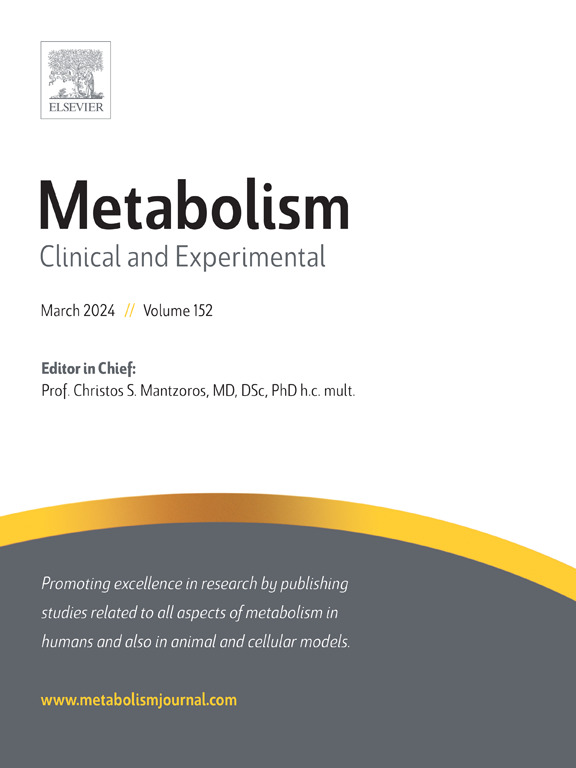在53026名成人中鉴定与多病相关的蛋白质和途径。
IF 10.8
1区 医学
Q1 ENDOCRINOLOGY & METABOLISM
引用次数: 0
摘要
背景和目的:多重发病,即多种慢性疾病的共存,是一项迅速扩大的全球卫生挑战,对患者、护理人员、卫生保健系统和社会产生深远影响。调查多种慢性疾病的决定因素和驱动因素是疾病管理和预防的重点。方法:这项前瞻性队列研究分析了英国生物银行从基线(2006年至2010年)的53026名参与者的数据,随访时间为13.3 年。使用Cox比例风险回归模型,我们描述了38种事件结局(31种慢性疾病,6种系统死亡率和全因死亡率)之间的共同和独特关联。此外,使用有序回归模型评估蛋白质水平与多发病(0- 1,2,3 -4或 ≥ 5种慢性疾病)之间的关系。对多发病相关蛋白进行功能和组织富集分析。鉴定了上述蛋白的上游调控因子。结果:我们证实,在Bonferroni校正后,972个(33.3% %)蛋白在至少两种慢性疾病中共享(P -7,其中93.3 %具有一致的影响方向),而345个(11.8 %)蛋白与单一慢性疾病唯一相关。值得注意的是,GDF15、PLAUR、WFDC2和AREG与20-24种慢性疾病的发生呈正相关(危险比:1.21-3.77),与多发病有很强的相关性(优势比:1.33-1.89)。我们进一步发现蛋白质水平可以由常见的危险因素解释,特别是肾功能、肝功能、炎症和肥胖,提供了潜在的干预目标。通路分析强调了免疫应答的关键作用,与蛋白质组学相关的三大转录因子是NFKB1、JUN和RELA。结论:我们的研究结果增强了对多重发病的生物学基础的理解,为疾病识别提供了生物标志物,并为治疗干预提供了新的靶点。本文章由计算机程序翻译,如有差异,请以英文原文为准。

Identifying proteins and pathways associated with multimorbidity in 53,026 adults
Background and aims
Multimorbidity, the coexistence of multiple chronic diseases, is a rapidly expanding global health challenge, carrying profound implications for patients, caregivers, healthcare systems, and society. Investigating the determinants and drivers underlying multiple chronic diseases is a priority for disease management and prevention.
Method
This prospective cohort study analyzed data from the 53,026 participants in the UK Biobank from baseline (2006 to 2010) across 13.3 years of follow-up. Using Cox proportional hazards regression model, we characterized shared and unique associations across 38 incident outcomes (31 chronic diseases, 6 system mortality and all-cause mortality). Furthermore, ordinal regression models were used to assess the association between protein levels and multimorbidity (0–1, 2, 3–4, or ≥ 5 chronic diseases). Functional and tissue enrichment analysis were employed for multimorbidity-associated proteins. The upstream regulators of above proteins were identified.
Results
We demonstrated 972 (33.3 %) proteins were shared across at least two incident chronic diseases after Bonferroni correction (P < 3.42 × 10−7, 93.3 % of those had consistent effects directions), while 345 (11.8 %) proteins were uniquely linked to a single chronic disease. Remarkably, GDF15, PLAUR, WFDC2 and AREG were positively associated with 20–24 incident chronic diseases (hazards ratios: 1.21–3.77) and showed strong associations with multimorbidity (odds ratios: 1.33–1.89). We further identified that protein levels are explained by common risk factors, especially renal function, liver function, inflammation, and obesity, providing potential intervention targets. Pathway analysis has underscored the pivotal role of the immune response, with the top three transcription factors associated with proteomics being NFKB1, JUN and RELA.
Conclusions
Our results enhance the understanding of the biological basis underlying multimorbidity, offering biomarkers for disease identification and novel targets for therapeutic intervention.
求助全文
通过发布文献求助,成功后即可免费获取论文全文。
去求助
来源期刊

Metabolism: clinical and experimental
医学-内分泌学与代谢
CiteScore
18.90
自引率
3.10%
发文量
310
审稿时长
16 days
期刊介绍:
Metabolism upholds research excellence by disseminating high-quality original research, reviews, editorials, and commentaries covering all facets of human metabolism.
Consideration for publication in Metabolism extends to studies in humans, animal, and cellular models, with a particular emphasis on work demonstrating strong translational potential.
The journal addresses a range of topics, including:
- Energy Expenditure and Obesity
- Metabolic Syndrome, Prediabetes, and Diabetes
- Nutrition, Exercise, and the Environment
- Genetics and Genomics, Proteomics, and Metabolomics
- Carbohydrate, Lipid, and Protein Metabolism
- Endocrinology and Hypertension
- Mineral and Bone Metabolism
- Cardiovascular Diseases and Malignancies
- Inflammation in metabolism and immunometabolism
 求助内容:
求助内容: 应助结果提醒方式:
应助结果提醒方式:


